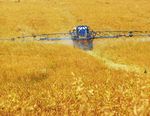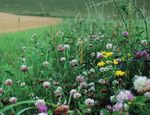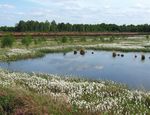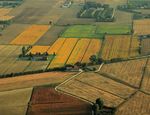Easy Guide - Insect Protection in Standards of the Food Sector
←
→
Page content transcription
If your browser does not render page correctly, please read the page content below
DECLINE OF INSECTS: TIME FOR ACTION
Easy Guide on Insect Protection
The integration of insect protection into sourcing strategies and guidelines is essential for companies of the food sector. Standards and la-
bels in the food sector ensure clearly defined quality criteria for a product and its production. Furthermore, such criteria act as guidance for
farming and can influence agricultural practices on a large scale. Given the dramatic decline of insects (including many pollinator species),
standards and labels need to ensure that the criteria not only contribute to their protection but also to the recovery of insect diversity and
population numbers.
This Easy Guide is particularly designed for quality, product and procurement managers, who are responsible for purchasing food products.
The guide supports managers to understand and to assess fields of action that are relevant for protecting insects and which should be cov-
ered by a standard or label.
This is the second Easy Guide published by the EU LIFE Food & Biodiversity project. The first guide explains
how managers can assess the effectiveness of the biodiversity criteria in standards and labels of the food sec-
tor. It is available in five languages and can be downloaded here:
https://www.business-biodiversity.eu/en/easy-guide-biodiversity-in-standards
Food Production and the Decline of Insects
Insects provide crucial ecosystem services, such as pollination, nutrient cycling, pest control and the provision of food for a wide range of
species. Thus, the decline of insects has an immediate negative effect on those functions.
Especially pollinating insects are essential for our global food production. According to the latest Global Assessment Report on Biodiversity
and Ecosystem Services of the World Biodiversity Council IPBES, more than 75% of global food crop types rely on animal pollination.
THE IMPORTANCE OF INSECTS Agriculture is Intensive agricultural prac-
important for tices and changes in landuse
• 75 % of global food crop types rely on the protection of including monocultures and
animal pollination, one third are insects because pesticide use threaten pol-
pollinated alone by bees.1 many species and habitats linating insects.2
• Insects drive & connect are closely linked to agricul-
regulating, supporting and cultural tural landuse.5
ecosystem services.2
Through flower strips,
hedges and nesting aids on
a Pro Planet plantations,
From 1989 to 2016 presence of
flying insect biomass wild bee species
in Germany declined doubled within
by 76%.3 eight years.6
4
Sources: 1: FAO (2018) Why Bees Matter.; 2: FAO (2016) Available via:
http://www.fao.org/news/story/ en/item/384726/icode/; 3: Hallmann et al.
10
(2017). DOI: 10.1371/journal.pone.0185809 ; 4: IPBES (2019) Summary for
Annual value of global Policy Makers; 5: Elevated Scientific (2016) Available via http://creativecom-
crop output up to in mons.org /licenses/by-nc-nd/4.0/; 6: Bodensee Stiftung, available via:
530 Billion Euro http://www.bodensee-stiftung.org/pro_planet_apfelprojekt.
is at risk due to pollina- Bees and butterflies may Icon designed by Kiranshastry and Freepik at www.flaticon.com and LynxVector
tor loss.4 face extinction.5,2 at www.fotolia.comBIODIVERSITY MANAGEMENT
Important Fields of Action with Benefits for the Protection of Insects
Biodiversity friendly agriculture builds on two main pillars. The first is to protect and enhance ecosystems and other ecological structures,
which serve as recreation area and habitat for a diverse range of animals, including insects. Secondly, any reduction of negative impacts that
farming has on nature also affects insect populations. Those two are underpinned by indirect measures aiming at supporting knowledge and
enhancing systematic approaches towards the protection of biodiversity and insects.
Creation, protection or enhancement of habitats (e.g. Reduction of negative impacts on biodiversity and ecosystems
creation of semi-natural habitats and biotope corridors) (e.g. reduction of pesticides)
BIODIVERSITY MANAGEMENT VERY GOOD AGRICULTURAL PRACTICES for MORE BIODIVERSITY
Indirect measures, supporting the two main fields for biodiversity protection (e.g. training of staff, pesticides storage systems,
environmental management systems etc.)
The following table shows fields of action that are relevant for the protection and promotion of insects. We also highlight standards which ad-
dress this fields of action with their criteria. Please note that this list is not comprehensive and standard systems that are not mentioned here
may as well contribute to or cover these fields of action.
BIODIVERSITY MANAGEMENT
Fields of Action A Selection of Standards
Creation, protection and management of ecological structures on • UEBT
agricultural land • Rainforest Alliance (2021)
• Fairtrade (Hired Labor Standard and Small
Diverse ecological structures like flower strips, hedges, trees (native species), per-
Producer Standard)
manent grassland, traditional orchards etc. serve as retreat areas, shelter and an
• GlobalGAP
important food source for insects/beneficial organisms. Their abundance on agri-
• Naturland
cultural land should be increased, while existing structures need protection from
• Bioland
disturbances through agricultural activities (e.g. fertilization, plant protection
• Bee friendly
products). To raise the quality for local fauna, only native plant species should be
• Demeter
used when maintaining old or implementing new ecological structure.
• PDO Laguiole, Comté, St Nectaire
• IP Suisse
• High Environmental Value
(Environmental certification level 3)
• Biocohérence
• BIO SUISSE
• Bee Friendly Farming (BFF)VERY GOOD AGRICULTURAL PRACTICES
Fields of Action A Selection of Standards
• UEBT
Reduction of pesticides
• Fairtrade (Hired Labor Standard and Small
In order to reduce the high decline of insects, a Producer Standard)
significant reduction of all pesticides and the use of • GlobalGAP
alterative measures for pesticides is necessary. Differ- • Organic Standards
ent approaches are possible, ranging from defining a • Rainforest Alliance
maximum threshold for the percentage of treated plots • QS Standard (limited IPM)
(e.g. max. 80 % of cultivation areas are treated with and 20 % of the area are • Bee friendly (level 3)
left free of pesticide) up to the permission to use only insecticide permitted for • High Environmental Value (Environmental
organic agriculture during the entire crop season. certification level 3)
• Biocohérence
Application of integrated pest management is a good approach that provides
• IP Suisse
crop-based preventive measures and damage thresholds (intercropping, crop rota-
• BIO SUISSE
tion, protection and enhancement of beneficial organisms etc.).
• Bee Friendly Farming (BFF)
• Standard for Sustainable Cattle
Protection of healthy soils – soil management Production Systems
and reduction of synthetic fertilizer • UEBT
• Rainforest Alliance
Soil is an important living and breeding space for • Fairtrade (Hired Labor Standard and Small
insects. Therefore, the protection of healthy and living Producer Standard)
soils correlates with the protection of insects. For • GlobalGAP
instance, intensive ploughing or tillage may affect • Organic Standards
nesting sites and survival of beneficial insects while an increase of soil organic • QS Standard
matter and a stable soil structure supports them. • PDO Laguiole, Comté, St Nectaire
• IP Suisse
Diverse cropping systems
A diverse cropping system supports insects with food • UEBT
and shelter. Starting with a heterogenic crop rota- • IP Suisse
tion, including cover crops and intercropping, up to a • BIO SUISSE
diverse crop mosaic in landscape.
Grass-based and pasture-based livestock
farming
Implementing multi-species grasslands with mixtures • PDO Laguiole, Comté, St Nectaire
of diverse legumes (entomophilous crops) provides • IP Suisse
shelter and food resources for insects. These grasslands • Bee Friendly
should be managed extensively; by closely controlling
the average livestock density grazing reducing the risk of overgrazing (loss of
biological diversity) and undergrazing (risk of afforestation).• UEBT
Protection of water – buffer zones • Rainforest Alliance
Water is a vital habitat for insects – within and • Fairtrade (Hired Labor Standard and Small
above. Therefore, the protection of waterbodies is very impor- Producer Standard)
tant for the protection of insects. • GlobalGAP
To protect these structures, buffer zones are essential and • Organic Standards
should go beyond what is legally required. • QS Standard
• IP Suisse
• Bio SUISSE
INDIRECT MEASURES
Fields of Action A Selection of Standards
Baseline Assessment Change of
regulation,
protection status of
surrounding land
List of Protected areas,
Biodiversity HCV areas, Species
measures priority areas
implemented
Setting Goals
Adaptation of
• UEBT
the goals?
Selection and implementation
of measures
• Demeter
• Rain Forest Alliance (2021)
• GlobalGAP
Monitoring
Biodiversity Action Plan (or similar)
A plan to enhance and conserve biodiversity on farm scale. It includes and supports
agro-ecological practices and highlights a sound biodiversity management. As such, it
includes a range of measures for the protection of insects.
Training and capacity building
A continuous improvement of agricultural practices is the key
to foster and sustain thriving of insects. The exchange of best • Bee friendly
practices as well as the training on topics like biodiversity and
more specificly about insect- and pollinator protection should
be taken up by all stakeholders in the foodsystem.LIFE Food & Biodiversity Project
The LIFE Food & Biodiversity Project is directed at standard setting organizations and companies with individual sourcing require-
ments. A European consortium of Global Nature Fund, Lake Constance Foundation, Fundación Global Nature, Instituto Superior
Técnico, Agentur auf!, Solagro, agence good for good provide practical support to biodiversity performance of the food industry by
■ Supporting standard-setting organisations to include efficient biodiversity criteria into existing schemes; encouraging food pro-
cessing companies and retailers to include biodiversity criteria into their respective sourcing guidelines
■ Biodiversity trainings for advisors and certifiers of standards as well as product and quality managers of companies
■ Implementing a Biodiversity Performance Tool and a cross-standard monitoring system on biodiversity
■ Communicating strongly to raise awareness among all stakeholders in the industry
■ Implementing Sector Initiatives on Biodiversity
■ Contributing to national and European policies such as the EU Pollinators Initiative.
We appreciate the support of:
With financial support of: Recognised as: Project Partners:
Further information: www.food-biodiversity.euYou can also read



























































